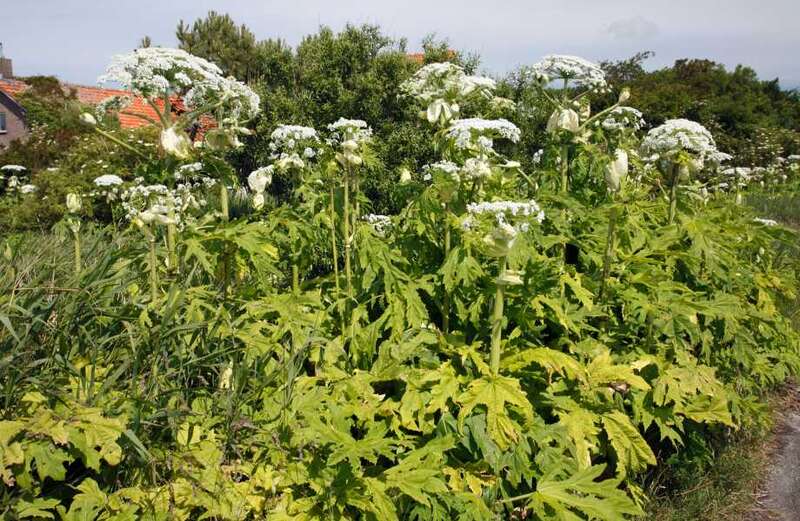AN invasive species dubbed "Britain's most dangerous plant" by experts can cause havoc in the garden - and on your health.
Giant Hogweed may look impressive but any contact with the sap of this plant can cause serious injury, particularly to your skin.

What is Giant Hogweed?
Giant Hogweed, or Heracleum mantegazzianum, is infamous among botanists due to its toxic properties.
The plant - which looks a lot like a bigger version of cow parsley, which you often see on verges, and in parks and woodland - earned its dangerous reputation because you don't have to break a stem or rub its sap into your skin for painful side effects to take hold.
Just brushing against the plant is all it takes to cause burns, lesions and blisters.
 Are there illegal baby names? Surprising monikers that are BANNED in other countries, from Sarah to Thomas
Are there illegal baby names? Surprising monikers that are BANNED in other countries, from Sarah to Thomas
Depending on the severity of the injury, pigmentation and long lasting scars may occur.
Mike Duddy, of the Mersey Basin Rivers Trust, branded giant hogweed "Britain's most dangerous plant".
He said: "Co-ordinated action is the only way to get rid of it. In the 1990s there was very little of it. The proliferation has got worse every year."
The Royal Horticultural Society (RHS) also describes the plant as a "serious risk to people who are unaware of its potential harm".
The Royal Horticultural Society (RHS) also describe the plant as a "serious risk to people who are unaware of its potential harm".
What does Giant Hogweed look like?
When fully grown, giant hogweed is aptly named.
The plant can grow up to 25ft tall, with long green stems, purple blotches, and huge branches of small white flowers and large green leaves.
The plant’s flower heads bloom in June and July and can reach up to 2ft across.
Giant hogweed can be mistaken for other plants such as cow parsley, cow parsnip, Queen Anne's Lace or elderberry as the flowers look similar.
Their size when fully grown is very helpful for identifying the harmful crop.
 All about Rachel Nickell who was murdered in front of her son Alex Hanscombe
All about Rachel Nickell who was murdered in front of her son Alex Hanscombe
Why does Giant Hogweed cause rashes, burns and blisters?
Giant hogweed stems have fine needle-like hairs that can cause extreme irritation.
While the sap in giant hogweed contains a chemical called furanocoumarins.
When this toxin comes into contact with the skin, it binds with DNA in skin cells, causing them to die.
The sap reacts with the melanin in your skin and removes protection that patch has from UV light, causing photosensitivity (where the affected area becomes highly sensitive to sunlight), resulting in nasty burns, lesions and blisters.
Those burns can last for several months and, even once they’ve gone, skin can remain scarred and sensitive to sunlight for years to come.
If the hairs of the giant hogweed plant or its sap come into contact with your eyes, they can even cause temporary or even permanent blindness in severe cases.
Children are believed to be particularly vulnerable to the impacts of the plant, with reports of several being hospitalised with injuries in recent years.
How do I treat burns from Giant Hogweeds?
The NHS website advises that if you come into contact with giant hogweed and you get a burn, you should wash the affected area with soap and water and then cover it, keeping it out of natural or artificial light.
If blisters appear, do not burst them! If the blisters are extensive, seek medical attention.
Should you get sap in your eye, flush the eye with a large amount of water and seek medical attention.
If you begin to feel unwell after contact with giant hogweed, speak to your doctor.
Ensure you thoroughly and quickly wash the clothes you were wearing when you came into contact with the plant.
And if you’re concerned that a child has come into contact with, or ingested giant hogweed, seek medical attention immediately.
Where does Giant Hogweed grow in the UK?
Giant hogweed was first introduced to the UK in 1817 when the Russian Gorenki Botanic Gardens supplied seeds to Kew Gardens.
It was used in ornamental gardens but soon escaped into the wild.
You are most likely to come across it while walking along rivers, streams or near a freshwater source.
The highly invasive plant can also be found on waste ground.
How do I get rid of giant hogweed?
Giant hogweed is vulnerable to herbicides such as glyphosate and triclopyr.
Applying these herbicides is effective, cost efficient and can be used to control a lone plant or a whole host of plants.
The RHS website states: "When controlling giant hogweed, always wear gloves, cover your arms and legs, and ideally wear a face mask when working on or near it.
"Cut plant debris, contaminated clothing and tools are potentially hazardous too.
"Wash any skin that comes in contact with the plant immediately.
"Ensure that contractors working on your land are aware of the risks and competent to deal with this weed."
It adds: "Protect yourself from any skin contact with the sap, especially your face, when cutting stems, and carry out control measures in overcast weather avoiding sunny periods.
"Larger scale areas are probably best left to the professionals, who should wear full protective clothing, especially if they are using a strimmer.
"Strimmers send sap and fragments flying so face protection is essential."
If you see giant hogweed in your garden or area, you should report it to your local council via their website.



































